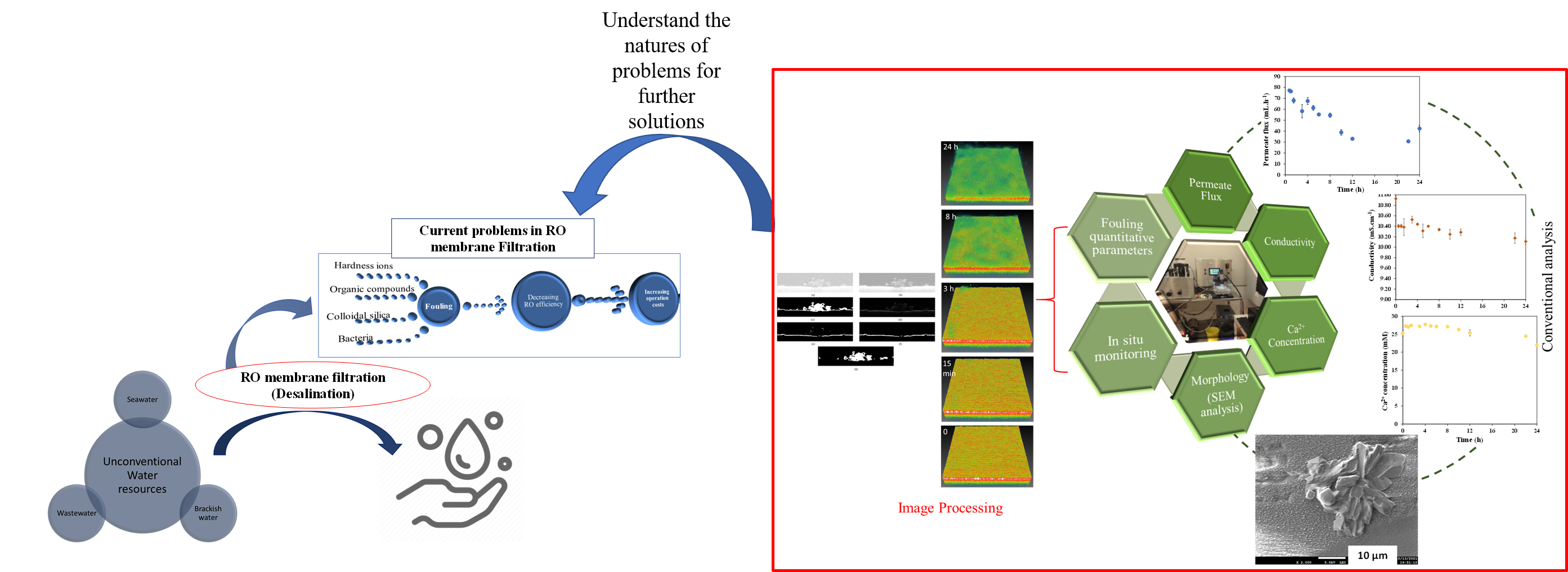2022 Annual Meeting
(702g) IMAGE Processing As a Tool in Fouling Characterization for Reverse Osmosis Desalination
Authors
Pham Le Phuong, T. - Presenter, Khalifa University
Ali, J., Khalifa University
Soufiane Jouini, M., Khalifa University of Science and Technology
Alhseinat, E., The Petroleum Institute
Water scarcity has been the most serious problem to resolve as the need for freshwater keeps increasing over time. The main existing solution is to convert unconventional water resources such as seawater, brackish water i.e. underground water, and wastewater into freshwater by employing desalination technologies. Basically, the technologies are divided into thermal-based processes and membrane filtration processes in which reverse osmosis (RO) membrane filtration is the most favored technique currently. Its advantages include high efficiency, low energy consumption, and low cost. However, due to the complexity of feed water, various matters can deposit on the membrane surface during the filtration process under highly applied pressure, which is called fouling. This generates a cake or gel layer on the membrane which leads to an increase in membrane resistance, reduction of filtration efficiency, and membrane shelf-life. Therefore, monitoring the growth of the fouling layers on the membrane during filtration is compulsory to understand insights into the fouling process. Optical coherence tomography (OCT) is a technique that allows in situ and rapid monitoring of the stages of fouling during filtration. However, the applications of OCT in RO membrane filtration are still restricted and primarily focused on biofouling and qualitative analysis. Therefore, this study aims to extend the application of OCT in the observation of scaling i.e. CaSO4 in real hydrodynamic conditions. The acquisition data was processed by a special digital image processing code to extract quantitative analysis data (volume and surface coverage proportion) of the scaling layer and correlate it to the RO performance parameter i.e. permeate flowrate. The digital image process primarily consists of image enhancement by 3D mean filter with a 5-voxels window, image segmentation using combination of thresholding and edge detection methods, and quantification of fouling parameters. The results showed that OCT can detect the concentration polarization and nucleation process at the first hour of the process and the growth of crystals from their nuclei after 1.5 h. After 8 h, when the fouling volume and surface coverage proportion reach 21.473×106 (µm3) and 41.51 (%), respectively, significant reductions of permeate flux, conductivity of concentrate, and Ca2+ concentration are recorded 54.52±1.94 (mL.h-1), 10.34±0.02 (mS.cm-1), and 26.28±0.08 (mM) compared to the initial values of 77.14±0.25 (mL.h-1), 10.93±0.42 (mS.cm-1), and 27.23±0.12 (mM), respectively. After 24 h operation, when 98.27 (%) of membrane surface is covered by fouling and 188.786×106 (µm3)is obtained as fouling volume, the operation parameters reach 42.34±3.05 (mL.h-1), 10.11±0.05 (mS.cm-1), and 21.78±0.28 (mM), respectively. The drops of permeate quality is also noticed via the increase of its conductivity, which is 7.85±0.43 (mS.cm-1) after 24 h in a comparison to 2.23±0.02 (mS.cm-1) as the initial value. In addition, the morphology of scales captured by OCT is compared with a scanning electron microscope (SEM). Therefore, this paper successfully introduces a methodology of using OCT in a combination with digital image processing as a promising and useful technique for quantitative the growth of fouling in membrane filtration processes.
Keywords: Optical coherence tomography (OCT), fouling, membrane-based separation (RO).
